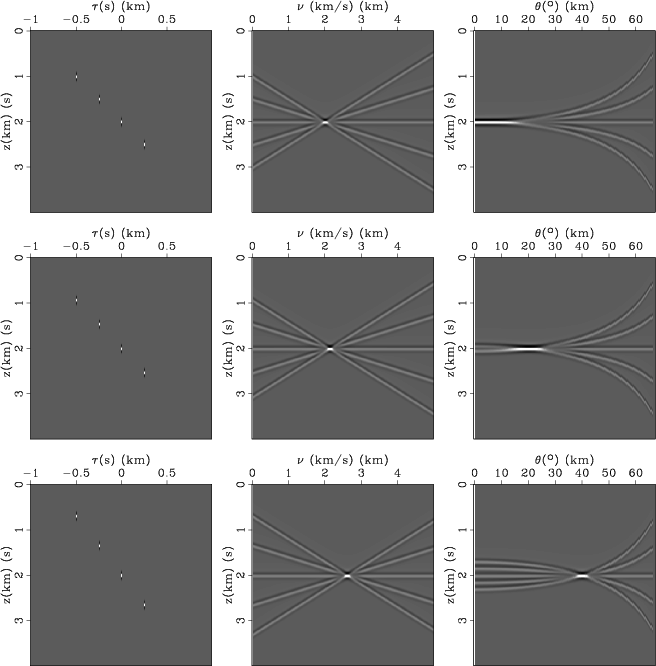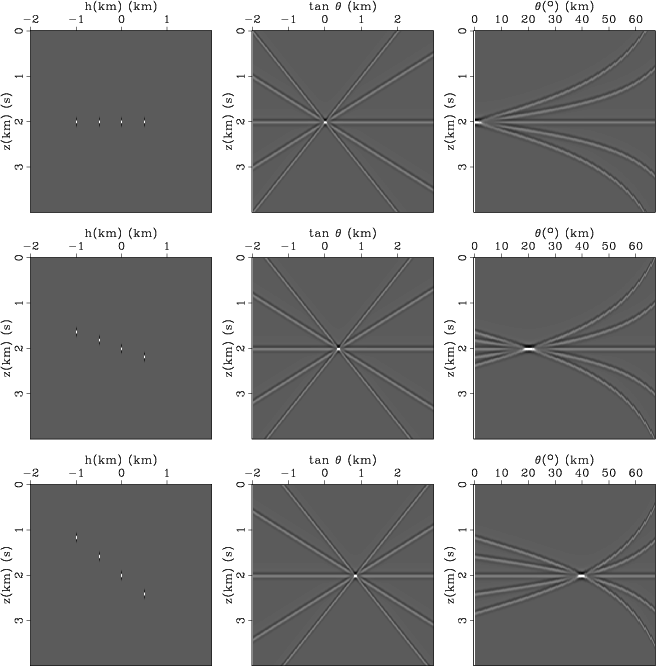|
|
|
|
Time-shift imaging condition in seismic migration |
In order to understand the angle-domain mapping,
we consider a simple synthetic in which we model
common-image gathers corresponding to incidence at
a particular angle.
The experiment is depicted in Figure 15
for time-shift imaging, and in Figure 16
for space-shift imaging.
For this experiment, the sampling parameters are the following:
![]() km,
km,
![]() km, and
km, and
![]() s.
s.
A reflection event at a single angle of incidence
maps in common-image gathers as a line of a given slope.
The left panels in Figures 15 and 16
show ![]() cases, corresponding to angles of
cases, corresponding to angles of
![]() ,
, ![]() and
and ![]() .
Since we want to analyze how such events map to angle,
we subsample each line to
.
Since we want to analyze how such events map to angle,
we subsample each line to ![]() selected samples lining-up
at the correct slope.
selected samples lining-up
at the correct slope.
The middle panels in Figures 15 and 16
show the data in the left panels after slant-stacking
in ![]() or
or ![]() panels, respectively.
Each individual sample from the common-image gathers maps
in a line of a different slope intersecting in a point.
For example, normal incidence in a time-shift gather
maps at the migration velocity
panels, respectively.
Each individual sample from the common-image gathers maps
in a line of a different slope intersecting in a point.
For example, normal incidence in a time-shift gather
maps at the migration velocity ![]() km/s
(Figure 15 top row, middle panel), and
normal incidence in a space-shift gather maps at
slant-stack parameter
km/s
(Figure 15 top row, middle panel), and
normal incidence in a space-shift gather maps at
slant-stack parameter
![]() .
.
The right panels in Figures 15 and 16 show the data from the middle panels after mapping to angle using equations (23) and (20), respectively. All lines from the slant-stack panels map into curves that intersect at the angle of incidence.
We note that all curves for the time-shift angle-gathers have zero curvature at normal incidence. Therefore, the resolution of the time-shift mapping around normal incidence is lower than the corresponding space-shift resolution. However, the storage and computational cost of time-shift imaging is smaller than the cost of equivalent space-shift imaging. The choice of the appropriate imaging condition depends on the imaging objective and on the trade-off between the cost and the desired resolution.

|
|---|
|
ttest
Figure 15. Image-gather formation using time-shift imaging. Each row depicts an event at |
|
|

|
|---|
|
htest
Figure 16. Image-gather formation using space-shift imaging. Each row depicts an event at |
|
|
|
|
|
|
Time-shift imaging condition in seismic migration |